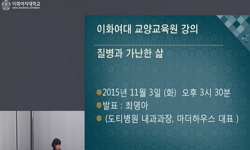This research analyze `poor' discourse of the young people who become accomplished from the Internet space with currently from the social inside which we are living `poor' discussions in what kind of method to come to be reproduced, the defendant pers...
http://chineseinput.net/에서 pinyin(병음)방식으로 중국어를 변환할 수 있습니다.
변환된 중국어를 복사하여 사용하시면 됩니다.
- 中文 을 입력하시려면 zhongwen을 입력하시고 space를누르시면됩니다.
- 北京 을 입력하시려면 beijing을 입력하시고 space를 누르시면 됩니다.
‘가난’담론의 형성과 자기 확대재생산 구조에 대한 연구 : 인터넷 사이버공간의 청소년 ‘가난’담론을 중심으로 = A Study on formation of `poor' discourse and self-expansive reproduction structure
한글로보기https://www.riss.kr/link?id=T11307531
- 저자
-
발행사항
서울 : 성공회대학교 일반대학원, 2007
-
학위논문사항
학위논문(석사) -- 성공회대학교 일반대학원 , 사회복지학과 , 2007. 8
-
발행연도
2007
-
작성언어
한국어
- 주제어
-
KDC
338
-
DDC
360
-
발행국(도시)
서울
-
형태사항
ⅳ, ⅱ, 134, ⅲ p. ; 26cm
-
일반주기명
지도교수 :정원오
- 소장기관
-
0
상세조회 -
0
다운로드
부가정보
다국어 초록 (Multilingual Abstract)
This research analyze `poor' discourse of the young people who become accomplished from the Internet space with currently from the social inside which we are living `poor' discussions in what kind of method to come to be reproduced, the defendant person who will live meaning which is immanent in that inside and the role it does.
Therefore it used a critical discourse analysis from this research. The reason this discussion as the social composition water the composition act which subject is spontaneous and passive setup reflection becomes accomplished from the whole in order to start with structure it is suitable in goal of this research which means all base is because being thought that from under dialectic interaction.
Meantime from research space `poor' discussions individual discussion of two kind, comfort receiving the pain of the poverty which is not ear book reason of namely oneself, it wants and `where poor' confession and comfort and poverty overcome in goal `poverty' with the discussion calming down are composed. And four appears with one text which is completed. Therefore the process of analysis comes to divide at three phases. The result of analysis with afterwords is same.
`Poor' confessions of the young people ostensibly the material like the pain which destitutely it receives it is visible but essentially it meat the crack of the relationship which besieges oneself who lives is ordinary with mediation. Therefore their `poor' confessions from dissolution etc. of destruction and relationship of relationship from the within estranging and the group from the group where oneself is related maintain the self-conceit core in the value which oneself selects and exalts. the problem occurred is a possibility even as signal of seeing, it makes
`Poverty' calming down meantime, the negation of `poverty which already exist' and tragic symbol govern a whole process. Like this namely the symbol of poverty the self-illumination theory which presents it overcome method and it restricts the autonomy of discussion from the nepotism which supports it, and psychological control method. Oneself who comes to be used specially generally from `poor' discussions compared to the comparative technique of the people who is inferior and with the confessor the reply person all it restricts the meaning reconstitution of `poverty', with the confessor the reply person all it will be able to fall in the comparative object which is inferior possibility with confirmation Sikkim this in order to do to make a fear have it is. The process where `the poverty' is like this finally it leads and it reproduces it makes the circulation of discussion govern finally and the negative symbol of oneself.
Meantime with `poor' confessions calming down, to be connected, it supplements each other from position of the observer and it comes it is completed with one text. It influences each other and it evolves and are completed in `poor' discussions which it exists. Therefore, `poor' discussions which are completed with one text do not participate with confession to calming down the young people, not to be, oneself, objective schedule `about poorly' in order to have the act form which is fixed * an accident form * a sentimental form. ' The social ceremony leads like this process about `poorly and it creates.
Conclusively to social gathering conscious inside `the malicious symbol which' is poor is immanent, the fear governs the inside characteristic of the social members in about it. Therefore the social members stand and in order to be free from like this symbol to endeavor they become. They in order to evade the fear of oneself stand with exclusion make discriminate in about the subject which possesses a malicious symbolic characteristic. The subjects which possess meantime like this symbolic characteristic are inferior, as the existence which is heterogeneous the hitter it makes oneself and social unequal structure naturally oneself, it makes accept.
Researcher led this research finally and to self-expansive reproduction process of `poor' discussions it stood `the thing to have the materiality where the poverty' is strong, it watches the whole it discovered with malicious symbol. About but like this `poorly' the epistemology prejudice more appears the result which is serious from actuality. Namely `issue' it comes `poorly' with `lines' `evils' gives the moral value which is both extremes and is with `profits' with problem of `damages' to reduce all problems of life it destroys the relationship individual selfishness. And it eats well, it is a moral line whose it is only to live well, like this society the above the human being must arrive becomes conclusion with the assertion which is a society.
국문 초록 (Abstract)
이 연구는 인터넷 공간에서 이루어지는 청소년들의 ‘가난’담론을 분석함으로써 현재 우리가 살고 있는 사회 속에서 ‘가난’담론이 어떠한 방식으로 재생산되어지며, 그 속에 내재되어 ...
이 연구는 인터넷 공간에서 이루어지는 청소년들의 ‘가난’담론을 분석함으로써 현재 우리가 살고 있는 사회 속에서 ‘가난’담론이 어떠한 방식으로 재생산되어지며, 그 속에 내재되어 있는 의미와 그 역할을 살피고자 한다. 그러므로 이 연구에서는 비판적 담론분석을 사용하였다. 그 이유는 이것이 사회적 구성물로서의 담론은 주체의 능동적인 구성행위와 수동적 체제반영이 변증법적 상호작용 하에서 이루어진다는 전체로부터 시작하기 때문에 구조와 의미를 모두 다루어야 하는 이 연구의 목적에 적합하다고 생각되기 때문이다.
한편 연구 공간에서 ‘가난’담론은 두 가지의 개별담론, 즉 자신의 귀책사유 없는 가난의 고통을 위로받기를 원하는 ‘가난’고백과 위로와 가난 극복을 목적으로 ‘가난’달래기 담론으로 구성된다. 그리고 이 둘은 완성된 하나의 텍스트로 나타난다. 그러므로 분석의 과정은 세 단계로 나누어진다. 분석의 결과는 다음과 같다.
청소년들의 ‘가난’고백은 표면적으로는 물질적 궁핍으로 받는 고통처럼 보이지만 본질적으로 그것은 일상적인 생활을 매개로 하는 자신을 둘러싼 관계의 균열을 의미한다. 그러므로 그들의 ‘가난’고백은 자신이 관계하는 집단에서의 소외, 집단 내에서의 관계의 파괴, 관계의 해체 등으로부터 자신이 선택한 가치에 자긍심을 유지하고 고양시키는 데에 문제가 발생하였다는 신호라고도 볼 수 있다.
한편 ‘가난’달래기는 이미 존재하는 ‘가난’의 부정적, 비극적 상징이 전체 과정을 지배한다. 즉 이와 같은 가난의 상징은 그것의 극복 방법을 제시하는 자조론과 그것을 뒷받침하는 가족주의, 그리고 심리적 통제 방식에서 담론의 자율성을 제한한다. 특히 ‘가난’담론에서 일반적으로 사용되어지는 자신보다 더 열등한 사람들과의 비교 기술은 고백자와 답변자 모두에게 ‘가난’의 의미 재구성을 제한하는데, 이는 고백자와 답변자 모두에게 열등한 비교대상으로 추락할 수 있다는 가능성을 확인시킴으로써 공포를 가지게 하기 때문이다. 결국 ‘가난’은 이러한 과정을 통해 자신의 부정적 상징을 재생산하고 결국 담론의 순환을 지배하게 된다.
한편 관찰자의 입장에서는 ‘가난’고백과 달래기는 서로를 보충하고 연결되어져 하나의 텍스트로 완성된다. 그것은 서로에게 영향을 주면서 진화되어 완성된 ‘가난’담론으로 존재한다. 그러므로 하나의 텍스트로 완성된 ‘가난’담론은 청소년들을 고백과 달래기에 참여하지 않고도 스스로를 대상화시켜 ‘가난’에 대해 일정한 행위양식·사고양식·감정양식을 가지도록 한다. ‘가난’에 대한 사회적 의식은 이러한 과정을 통해 생성된다.
결론적으로 사회적 집합의식 속에는 ‘가난’이라는 악의 상징이 내재하고, 그것에 대한 공포는 사회구성원들의 내면성을 지배한다. 그러므로 사회구성원들은 이러한 상징으로부터 자유롭기 위해서 노력하게 된다. 그들은 자신의 공포를 회피하기 위해서 악의 상징성을 보유한 주체에 대한 배제와 차별을 하게 된다. 한편 이러한 상징성을 보유한 주체들은 열등한, 이질적인 존재로서 자신을 타자화시켜 사회적 불평등 구조를 스스로가 당연하게 받아들이게 된다.
결국 연구자는 이 연구를 통해 ‘가난’담론의 자기 확대 재생산과정에는 악의 상징으로서의 ‘가난’이 강한 물질성을 가지고 전체를 감시하고 있다는 것을 발견하였다. 그러나 현실에서는 이러한 ‘가난’에 대한 인식론적 편견은 더욱 심각한 결과를 나타난다. 즉 ‘부’와 ‘가난’에 ‘선’과 ‘악’이라는 양극단적인 도덕적 가치를 부여함으로써 삶의 모든 문제를 ‘이익’과 ‘손해’의 문제로 환원시키고 개인을 이기화시켜 관계를 파괴한다. 그리고 잘 먹고, 잘 사는 것이 유일한 도덕적 선이며, 이러한 사회가 인간이 도달해야 할 이상사회라는 주장으로 귀결된다.
목차 (Table of Contents)
- Ⅰ. 서론 = 1
- 1. 문제 제기 = 1
- 2. 연구 목적과 필요성 = 4
- Ⅱ. 이론적 배경 = 8
- 1. 담론이란 무엇인가? = 8
- Ⅰ. 서론 = 1
- 1. 문제 제기 = 1
- 2. 연구 목적과 필요성 = 4
- Ⅱ. 이론적 배경 = 8
- 1. 담론이란 무엇인가? = 8
- 1) 담론의 정의 = 8
- 2) 담론의 구조와 배제 = 11
- (1) 담론과 의미의 생산 = 11
- (2) 담론의 구조, 에피스테메, 아키브 = 14
- (3) 담론의 내부 구조적 배제 수단 = 16
- (4) 담론의 외부 구조적 배제 수단 = 17
- (5) 담론의 물질성과 권력지향성 = 20
- (6) 비판적 담론 실천을 위하여 = 21
- Ⅲ. 연구 방법 = 23
- 1. 연구 대상 = 23
- 2. 연구 방법 = 25
- 3. 분석틀 = 27
- 4. 연구 과정 = 31
- Ⅳ. 연구 결과 = 33
- 1. ‘가난’고백 = 33
- 1) ‘가난’에 대한 의문 = 33
- 2) ‘가난’의 발견 = 37
- 3) ‘가난’의 인식 = 42
- (1) 관계의 욕구로부터(왕따에서 ‘가난’으로) = 42
- (2) ‘구별 짓기’의 과정을 거쳐(청소년 소비의 이중성) = 46
- (3) 낙인의 결과로서(부정적 상징으로서의 ‘가난’) = 51
- (4) ‘가난’의 인식 = 53
- 4) ‘가난’의 극복 = 56
- 5) ‘가난’의 수용 = 60
- 6) ‘가난’에 대한 저항 = 62
- 2. ‘가난’달래기 = 68
- 1) ‘가난’달래기의 양면성 = 68
- 2) ‘가난’달래기의 배경: 자조론과 가족주의 = 76
- 3) ‘가난’ 달래기의 심리 통제적 양식 = 82
- 3. 소결: ‘가난’의 재생산 = 99
- 1) ‘가난’의 의미 = 99
- (1) ‘가난’의 구성요소 = 99
- (2) ‘가난’의 주체적 의미 = 100
- 2) ‘가난’담론의 의미 = 103
- (1) 상징의 재생산 = 103
- (2) 사회적 사실로서의 ‘가난’담론 = 104
- (3) ‘가난’담론의 구조와 에피스테메(Epistēmē)와 아키브(Archive) = 106
- 3) ‘가난’담론의 물질성과 권력지향성 = 109
- 4) ‘가난’담론의 사회적 기능 = 112
- Ⅴ. 결론 = 115
- Ⅵ. 참고문헌 = 121
- ABSTRACT = 131












